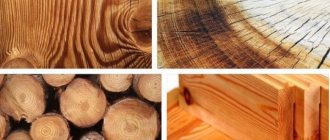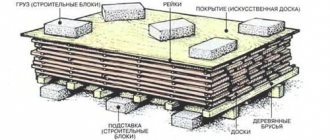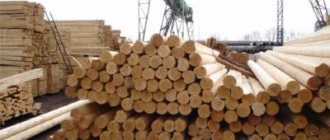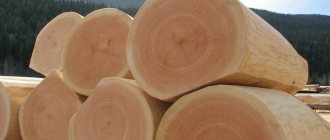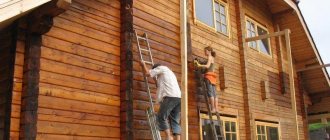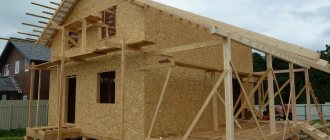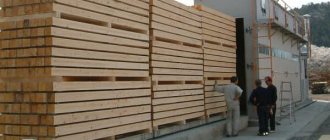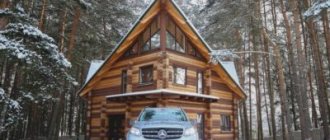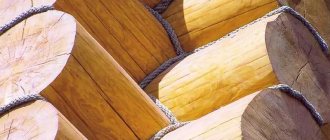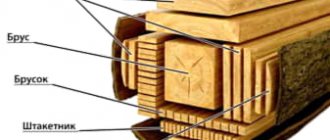As the tree grows, it fills with water from the ground through its roots. This way it absorbs nutrients that promote development. Then, when the trunk is cut down into blanks, some of the moisture remains with it. Wood moisture content should not exceed 22%. Below 15% it will not be possible to dry it naturally, since the external environment also feeds the material with liquid. The indicator of the amount of moisture affects the properties of wood and how it will behave during processing. Excessive amounts of water lead to mold and rot.
About the quality of lumber
Natural wood is sawn into lumber, which varies in size, shape and quality.
According to their shape, lumber is divided into boards, beams, beams, slabs, sleepers and other types. Each type of lumber is used for a specific purpose.
Cutting logs into lumber
More details:
Types and scope of use of lumber
In the production of carpentry and construction, boards are most often used. This is thin lumber, the width of which significantly exceeds the thickness.
To make all lumber, coniferous and deciduous trees are sawn. In order to reduce costs, many manufacturers violate the technology of sawing and storing wood. High-quality lumber is recognized by certain characteristics.
The signs of high-quality lumber are:
- compliance with state standards for key indicators;
- high grade;
- permissible humidity level;
- absence of defects and rot.
Hydraulic conductivity
The moisture conductivity of wood depends on the direction. The radial moisture conductivity of pine and especially ash is greater than the tangential one (according to Artsikhovskaya); At the same time, with increasing temperature, the moisture conductivity increases, which is very important for chamber drying.
Due to moisture absorption, bound moisture accumulates, which entails the opposite phenomenon to shrinkage, that is, swelling, which obeys the same laws as shrinkage.
The least swelling is observed along the fibers, the greatest - across the fibers in the tangential direction.
The ability of wood to swell is used in the manufacture of barrels, wooden ships, wooden pipes, when finishing surfaces (accidental dents from impacts can be eliminated by wetting and local heating, as a result of which, under the influence of swelling and increased elasticity, curved fibers are straightened), etc.
The ability to absorb droplet liquid water is called water absorption.
The maximum amount of water that can be absorbed under given conditions is determined by water capacity, and the rate of absorption is characterized by water conductivity.
When wood is immersed in water, the capillary spaces (vessels) are first filled, and the state of saturation occurs after a very long period of time. Deciduous species are saturated with moisture faster than coniferous ones, and in the first case the condition of the vessels (clogged with tills or not) is of great importance.
Water capacity and water conductivity depend on many factors and, above all, on volumetric weight: with a decrease in volumetric weight, water capacity increases. Resinous substances present in conifers and gum-like substances in deciduous trees reduce water capacity.
A big difference in water capacity and water conductivity is observed between the core and sapwood: blockage of the water-carrying elements of the core sharply reduces these properties.
Water capacity also depends on temperature, increasing as the latter decreases (according to Dunlap). The shape and dimensions of the assortment or part are also significant. Water absorption occurs mainly through the end surfaces, therefore the water conductivity along the fibers (the direction of moisture movement in a growing tree) will be greatest.
Transverse to the fibers, the water conductivity is extremely low and, with sufficient layer thickness, is practically unimportant. The difference between radial and tangential water conductivity cannot be considered established, since studies carried out to date have given conflicting results.
State standards for lumber
State standards (GOST) have been developed for lumber, which establish standards for size and quality during production and storage.
Compliance with regulatory standards is the first sign of quality material.
The size variation of the boards depends on the accuracy of the equipment settings and the speed of sawing the logs. Boards with different sizes cannot be adjusted exactly to each other. This does not apply to boards sawn according to GOST, since they are allowed to deviate from the standard by no more than 2 mm.
Lumber will always be of high quality if it is manufactured and stored taking into account the requirements of the following state standards:
Standards for softwood lumber:
- GOST 8486 - Standards for technical indicators of materials for the national economy and for export.
2. GOST 3808.1 - Storage and atmospheric drying of materials.
3. GOST 24454 - Dimensions of edged and unedged materials for the national economy and for export.
For lumber from hardwood: GOST 2695 - technical requirements for materials intended for the national economy.
For blanks and lumber from deciduous and coniferous trees: GOST 1973 - drying in air-steam chambers.
Standard board sizes include:
- width - 200, 150, 100 mm;
- thickness - 50, 40, 25 mm;
- length - 6, 3, 2 m.
Secrets of GOST 8486-86 Softwood lumber
Lumber grade
One of the signs of lumber quality is grade. It is indicated in the certificate for the batch of material.
The grade is determined by the number of defects on the wood. Defects include all defects that arise during the growth and processing of wood. All types of mechanical damage are not considered defects.
Wood defects
Wood is assessed for the following defects:
- Cracks appear for various reasons. Most often they occur due to swaying of the tree trunk as it grows. The cause of cracks is frost. Uneven drying also causes cracks. It is impossible to get rid of this defect, since it is of natural origin.
Cracks in lumber
- Resin pockets - when insects grow on coniferous trees, they create tunnels. The voids are filled with resin. After cutting, the resin pockets deform the lumber.
Resin pocket
- Knots are tree branches overgrown with a trunk. Such formations on the board make it difficult to process, and during drying they often fall out, forming holes. With this defect, the physical characteristics of the material are reduced.
Knots on the board
- Curvature is a defect in many trees. When cutting crooked wood, low-grade material and a lot of waste are obtained.
Board curvature
Types of wood
The grade of lumber is assessed by the number of defects. There are 5 varieties.
- The selected version of lumber has almost no knots, cracks, or flaws. There are no fungi or putrefactive lesions on these boards. There are almost no natural flaws in such materials.
- Grade 1 lumber is made from trees with a small number of cracks, knots and pockets. The bitches must be healthy.
1st grade edged board
- Grade 2 lumber has softer requirements and has some flaws. No more than two knots per linear meter. There is wane.
2nd grade edged board
- Grade 3 lumber is characterized by a wavy surface and small tears. The presence of fungus, putrefactive lesions, and defects of natural origin cannot be ruled out.
3rd grade edged boards
- The disadvantages of grade 4 lumber are visible to the naked eye; they have a lot of damage. In this variety, up to 10% rot is allowed. These boards are the cheapest.
High-quality lumber has a grade no lower than second.
1st grade board, truth and deception
What are the risks of using a wet board?
The frame wall is sealed on both sides with films. The moisture that was in the board at that moment remains in the wall FOREVER. This immediately leads to the formation of mold.
Never mind the accuracy and the cracks that will appear when it dries. This is being resolved. The biggest problem is mold.
Rotting of boards and their destruction is the number one danger. This video clearly shows the consequences.
The main problem is black mold. These are not just some health problems. This is a danger to life.
I heard from one grandfather: “If black mold appears in the house, you cannot get rid of it. Just burn it down and build a new one"
“In 100% of cases, oncology is diagnosed along with the presence of black mold in the body”
My doctor of bioresonance diagnostics
From my own experience, I know that it’s unknown where a child’s allergies or asthma come from; constant sick leave can be due to mold. You may not be aware of its existence in the wall for years.
Now that we know the enemy by sight, we can move on to solutions.
Moisture content of lumber
One of the important criteria by which the quality of lumber is assessed is its moisture content. Initially, bound moisture is present inside the wood cells, and tissue capillaries and channels are filled with free moisture.
Moisture gets into lumber in different ways. Firstly, the sap from the tree remains in the wood fibers, and secondly, due to hygroscopicity, the humidity is affected by the environment.
At the time of cutting, the natural humidity of the tree ranges from 25 to 80%. All lumber must be dried naturally or artificially before use.
Types of wood moisture content:
- wet wood (floated) – 100% or more;
- freshly sawn – 50-100%;
- air-dry – 10-20%;
- room-dry – 7-10%;
- absolutely dry – 0%.
The types of lumber differ in the degree of moisture content. For work, as a rule, wood with equilibrium moisture content is used. It occurs when lumber has been in conditions with constant temperature and humidity for a long time, and therefore the process of saturation with moisture and drying has completely stopped.
Equilibrium moisture is established naturally by changing temperature or relative humidity, and is determined from the table.
Equilibrium humidity table
When working with lumber of equilibrium moisture content, there is no drying out, swelling, cracking or warping during the operation of the products.
To achieve the desired humidity threshold, wood is dried artificially (in dryers) and naturally (in the open air).
Drying wood. 4 practical examples
Lumber will be of high quality if it has passed the following stages of preparation:
- After purchase, the boards are subjected to atmospheric drying in the open air with good ventilation for up to a year.
- Before use, lumber is brought into a room where it dries for several weeks or months.
- After chamber drying, the boards lie in the workshop and gain equilibrium moisture content.
What should be the moisture content of wood for carpentry work?
Determination of moisture content of lumber
The moisture content of lumber is determined in different ways.
Precise methods include the gravimetric method (using scales) and the electronic method (using a moisture meter).
The approximate moisture content of lumber is determined in the following ways:
- evaluate the color of a fresh cut. When the wood is dry, the cut is dark, and the cut is light in color when the material is damp;
- check by touch. A dry board has a hard surface and it is easy to drive a splinter into your hand;
- drill a hole to a depth of 4 cm, and then hold the drill. When the material is dry, the drill will smoke, and if it is wet, chips will appear.
Remember that being outdoors for 1-3 months makes the timber practically unsuitable for capital construction. The top layer of wood dries much faster than the inner layer, which creates a strong pressure difference, causing the surface to burst and deformation of the material along its entire length. Such timber can be used only for minor, minor repairs or construction of structures that will not bear a serious load.
How to determine wood moisture content without a device
Which types of wood are best to choose this or that furniture from?
What to consider when choosing
- Furniture made of maple wood fits perfectly into the Scandinavian and Provence style.
- Oak furniture looks impressive in different interior styles, including loft.
- When properly processed, cherry successfully imitates mahogany.
- Conifers create a healthy ecosystem in nurseries.
- Beech is great for allergy sufferers.
- Cedar is used to make luxury outdoor furniture - verandas, terraces and patios - as well as spectacular carved elements.
- Larch becomes even harder when exposed to moisture, so it is suitable for long-term unheated country cottages. It is used to make furniture for swimming pools, showers, saunas, loggias and terraces, as well as kitchen units, including countertops and space elements near sinks. Larch furniture looks great in Alpine style.
- Alder does not absorb foreign odors, so it is suitable for furnishing kitchens. Its moisture resistance is comparable to ceramic tiles. Alder wood has anti-allergenic and antibacterial properties, making it suitable for children's bedrooms and bedrooms.
- At dusk, pine furniture looks much lighter than other types. Wood releases phytoncides, which create a favorable indoor microclimate.
- Mahogany and other exotic types of wood are used for finishing because of their exceptional cost.
- Over time, any natural wood changes its color to a greater or lesser extent - dark wood becomes lighter, and light wood becomes darker.
The best wood for furniture is the one that suits you in terms of technical, aesthetic and price characteristics. To consult an expert in St. Petersburg, contact us in any convenient way.
How to choose quality lumber
The lumber supplier is selected based on the results of the following inspections and checks.
1. Inspection of lumber storage conditions at the supplier. Boards should be stored in stacks with gaps. Transverse bars are laid between the layers, which create conditions for ventilation. When properly stored, lumber does not “bloom.”
Lumber storage
2. Selective control with a tape measure of the accuracy of cutting boards in accordance with the standards. For high-quality lumber, the discrepancy does not exceed 2 mm.
Measuring the width of the board
Measuring board thickness
3. Checking the compliance of the number of knots and defects with the declared type of lumber. Visually, defects on the boards are easily identified.
4. Inspection of the color and texture of the boards. Spots, blueness and other darkening of the surface are a sign of putrefactive processes in the material.
Mold on lumber
5. Strength test. Loose material breaks at the edge. This indicates that the lumber was made from dead wood or stored in conditions of high humidity. Wane reduces the strength of the board, since a bug can hide under the bark and make moves in the material.
Board with wane
To make working with wood enjoyable and give good results, it is necessary, first of all, to work with high-quality lumber.
How to choose lumber
Author: Victor Prokhorov
Using materials from YouTube channels: Dmitry Sidorov, Sergey Voronov, Alexander Workshop, Yuri Primachenko. And websites: sushilnye-kamery.ru and derevok.narod.ru.
Method 3. Leave the board to dry in the frame
This is construction in 2 stages. Briefly, the essence: we buy a raw board, build a frame, cover it with a roof, and sheathe the outside. We leave it under the roof for three months. Every 2 weeks we measure the humidity of the frame. As soon as the wood is dry, we lay the insulation.
We save 200 thousand on this by taking a break of 2-3 months.
Only self-builders can afford this, as they will not have to pay a crew for the entire 3-4 months while the frame dries.
This method is recommended by professional builder Nikolai Malyshev. Here is a detailed video with the argument:
Residents of Nizhny Novgorod who do not want to build themselves are lucky. This is not an advertisement. Below the video there are contacts of Nikolai and his company. They run a channel on YouTube, which means they bear reputational risks. And this already significantly increases the likelihood of a high-quality result.
The downside is that there will be gaps. There are several solutions:
- we look where it has dried out and caulk it with jute or foam
- initially we lay jute
The saw blade does not warp if it is installed correctly. On the contrary, it does not allow the frame to warp.
Antiseptic treatment at your discretion. Strictly speaking, according to GOSTs, only lumber located in the ground, or 200 mm from the ground, can be treated with an antiseptic. Everything above is not subject to mandatory processing. Therefore, minimal processing: piping crown and base joists.
But you shouldn’t skimp on antiseptics, especially since we have an article about the most powerful DIY wood antiseptic.
This method is from a person who builds custom houses. He cannot sign a construction contract, deliver materials and leave for 3 months. If he had such an opportunity, I think he would use method 2.
How to determine the quality of lumber when purchasing?
It is very easy to find lumber for construction in any store, but, unfortunately, the product is not always of high quality. You need to know the features of choice for a good result of your work, so let's look at some criteria for selecting quality lumber.
When purchasing, ask what type of wood you have.
There are standards for edged lumber, and grade is one of them. If you expect to place the main load on this raw material, then first and second grade wood is ideal for construction. The remaining two grades are the result of the fact that the material does not meet existing standards, so they are only suitable for economic needs.
Make sure that there is no wide variation in sizes in the batch of edged lumber
To check this, you need to have a table of standards for the main dimensions of lumber. Most often you can find sawn timber in sizes - 10x10 cm, 10x15 cm, 15x15 cm with a length of 6 meters. When purchasing, use a tape measure to check the overall dimensions (width and thickness) to confirm the stated dimensional standard of lumber, which should not exceed the approved standards.
Check the moisture content of the wood
Poor wood strength can make itself felt immediately after installation, when nothing can be changed. As a rule, this happens due to moisture ingress during storage of the material or its transportation. You should opt for dried wood, because it is most suitable for high-quality construction. It is also worth paying attention to the appearance of the tree: from constant exposure to air, the tree begins to darken.
Match the weight of lumber
You should not use products for work that have not been dried. Such materials are much heavier, therefore, with large structures they will deform and crack over time. If you placed such wood in separate stacks before construction, you should lay it out so that each stack is not higher than 3 meters due to the possibility of deformation under its own weight.
Pay attention to the price of materials
Try to calculate how much certain materials will cost you. Standard-dried lumber will cost many times more than those with a higher moisture content. Quality materials are stored in separate sealed containers to prevent air and unnecessary moisture. Call suppliers of edged materials, because sometimes you can purchase some structural elements much more profitably. If you still decide that it would be more profitable to change the type of wood rather than looking for one type of higher quality, you will be able to find a product that will be acceptable in both price and quality!
Lumber purchasing process
Specific gravity of wood
To determine the weight of wood, a quantity called density or specific gravity is used. It is calculated by the ratio of the mass of the material to a unit volume. This parameter is very variable and depends on humidity and wood type, so it is customary to use its average value. To calculate this value proceed as follows:
- The mass of wood is determined by weighing.
- Calculate the volume. It is calculated using a special method, taking into account only the volume of clean wood without voids that are formed during installation.
Density is usually calculated using the natural moisture content of a particular material. The specific gravity of any wood is measured in kg/m3 and entered into the table.
Why can’t we get quality lumber?
The topic of wooden house construction in our country is worth returning to again and again, and again it should be recalled that this topic is most relevant specifically for Russia, and not for Canada, Finland or Japan. Due to our much harsher climate, it is completely impossible to use construction technologies that are successfully used all over the world. But many of our apologists for “cheap housing construction” are starting to argue about something they have no idea about.
And they have no idea at all about the quality of construction wood we sell today. The following fact should be cited: in no store with us you will not find the highest quality wood, even for a lot of money. Such wood is exclusively imported, consumed exclusively by elite developers, and its share in the market is very negligible. Moreover, it is so tiny that there is no point in talking about any statistical error.
And our domestic wood, even that which goes under the “extra” grade, does not meet not only Western criteria, but also domestic ones, in particular the former Soviet ones. And this is not even talking about lumber, which only “budget” developers can afford. Those are generally of terrible quality, although they often visually look like nothing.
It is not profitable for manufacturers to produce high-quality lumber
And it should be repeated again and again: it is simply not economically profitable for our manufacturers to produce high-quality lumber, even the “extra” grade - and that is defective. And if someone suddenly starts telling you that domestically produced wood can be found, albeit at a high price, then this is also a lie. Today, due to the unprecedented rise in prices for building materials in general and wood in particular, all “extra” goes exclusively to Finland and other European countries, and those worse grades go to China.
As is well known to everyone involved in the construction industry, the elite sector in the individual housing construction market (individual housing construction) in Russia occupies less than 1%, that is, there is simply no demand. And in conditions of such low demand, what fool would produce elite wood? That's right - none. If there is no demand, then even the social security authorities will not invest money in expensive equipment and pay salaries to super-duper specialists, for whose skills there is no demand at all.
Lack of high-class specialists
Another point follows from this. Since there is no demand for a quality product, there are no super-duper specialists who know how to make such a product. Where will they come from if all our specialists make money from cheap consumer goods? This is how it turns out that in the absence of demand, high-quality lumber can only be bought abroad, at exorbitant prices and with a long delivery time.
Well, there will always be some well-informed patriots who probably know the location of the factory where high-quality lumber is produced, and will begin to distribute to everyone around them the addresses of stores where such lumber can be bought.
But this is all just waving his arms purely for visual effect. Nobody is interested in playing conspiracy theories on the domestic lumber market, because any fool can understand why we don’t have high-quality construction wood - it’s a lack of demand.
However, this is already a journey in a circle and repetition of the material covered. Therefore, this article should end with one more fact - that’s why we don’t have frames that would last more than 5-10 years, because they are all made from low-quality lumber. But we don’t build frame houses from high-quality imported lumber. If they build, it is only from timber, and then only laminated veneer lumber. And this is luxury construction, which occupies less than 1% of the domestic construction market.
To understand this, all you have to do is study official statistics, and not spread around some conspiracy stories that are very far from reality.
Drying
Natural humidity (that is, the humidity present at the time of harvesting the tree) can reach 80%. It is distributed unevenly throughout the volume of the tree, which makes complex processing impossible.
Obviously, the material for making furniture must be properly dried. There are two main approaches to removing moisture from wood:
- Natural drying. The process takes place in atmospheric conditions due to constant air circulation. You can organize it even at home, however, there is a natural drying limit of 12-15%. To produce high-quality furniture, the wood needs to be dried more strongly. In addition, atmospheric drying takes a long time.
- Artificial drying. It is performed in special installations under the influence of heat guns, heaters and other devices that accelerate the removal of moisture. It looks quite simple, but in practice artificial drying causes a lot of difficulties. At a minimum, due to the fact that with sudden changes in temperature, wood can become damaged (cracks). Also, the material can simply be overdried, which negatively affects the durability of the wood.
Proper storage of wood after drying is of great importance, and therefore for furniture production you should not purchase materials from dubious suppliers.

